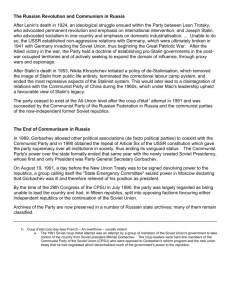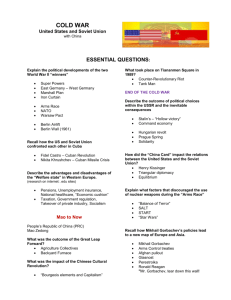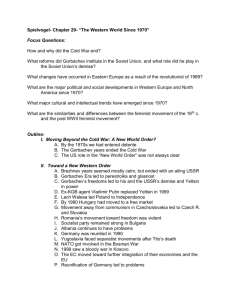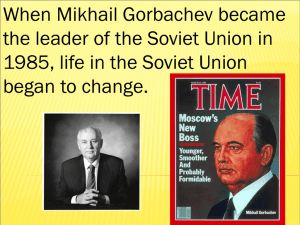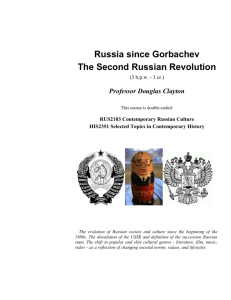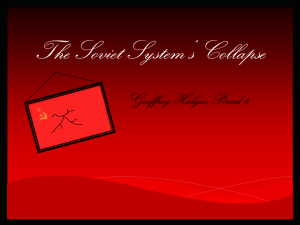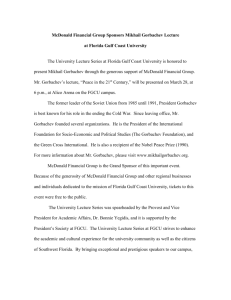Nov 30th - Presentation 1
advertisement
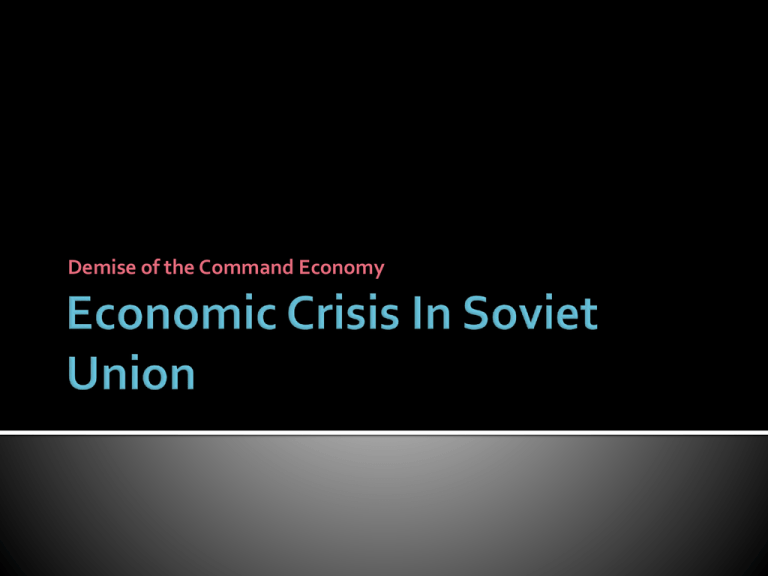
Demise of the Command Economy Command economy directed from a central planning commission. Most advanced nation in rocketry in mid fifties. Soviet leader Nikita Khrushchev predicted Soviet Union will surpass west economically in next twenty years. Gross National Product(GNP) was 6% per year. Adopted by Stalin (1930s) After taking power in 1927, Stalin banished private enterprise and imposed strict authoritarian control over the economy. Combined communist ideology and Russian nationalism to build socialism. Main priority was to build military strength through rapid industrialization. Large enterprises made centralized control efficient Enterprise Branch Ministers Gosplan Council of Ministers Managers were told what and how much to produce Price of commodities set by central authority Prices of social necessities set below production costs Elements of market system present. Enterprises allowed to retain a portion of their profits. Cost of production much less than the cost of manufactured goods, resulting in a substantial profit turned over to the government. ADVANTAGE Rapid industrialization High rates of economic growth by western standards until mid 1970s Surpassed United States in production of many industrial and farm products by 1975. World’s largest producer of basic commodities in 1989. Real per capita consumption increased by 150% in between 1950 and 1970. High literacy rate. Health care easily available. No unemployment. Guaranteed housing at minimal price. DISADVANTAGE/PROBLEMS Inefficient Rigid economic system not open to rapid technological changes. Complex annual planning. Lack of innovation for plant managers. Lack in planning led to shortages. Prices poorly reflected cost or demand “Soft” budget constraints. Quantity over quality. Growth through oppression and not technological progress. Access to commodities became a struggle for consumers, whereas party elites enjoyed imported products. From 1966-1970 GNP held at 5.3 From 1971-1975 GNP fell to an averaging 3.7 per year. After 1975 GNP averaged between 2.6 and 2.7 per year. Lack of sophisticated techniques in computers, software and communications electronics, and the design and manufacturing automobile Under Khrushchev’s liberalization program, major strides were made in housing, education and health care. More attention given to consumer goods; income inequality was reduced. Amidst the relaxation of the police state and the decline in Communist Party discipline, the black market flourished 1976-1980 five-year plan deliberately set quotas based on a lower growth rate Managerial and worker discipline declined with the rise in corruption and lack of incentives to motivate a socially protected workforce. Despite economic stagnation, the average Russian was not immediately disturbed. (nonexistent unemployment, higher than ever standard of living, free healthcare and education, inexpensive housing, political freedom, etc……..) Mikhael Gorbachev was elected general secretary of the Communist Party on March 11, 1985 after early deaths of Yuri Andropov and Konstantin Chernenko. HE wanted to prove that socialism can adapt, innovate and be as productive as capitalism. Gobachev introduced perestroika-his vision of a new socialism. Perestroika program consisted of “three closely intertwined directions fit together into a vague concept of uskorenie (acceleration).” Three directions Technological progress “democratization” of the economy Social orientation of production A few months after taking office in 1985, Gorbachev adopted the incentive system , which relied on success indicators that complemented the mandated output targets This system lowered branch ministries’ interference in the day-to-day operations of enterprises . Gorbachev also launched an aggressive campaign to decrease alcohol consumption Production and sales of alcohol were cut; harsh penalties imposed for public drunkenness Ambitious investment campaign launched with emphasis on the machinebuilding industry, which supplied most of the capital equipment for the economy. Gorbachev was criticized by Western observers for making adjustments rather than fundamental changes Investment was dramatically increased Even though there was increased investment, neither productivity nor product quality showed improvement Hoarding mentality led to more shortages. Shortages provoked an up rise in black market. Input shortages due to reduced centralized coordination. Monopolistic enterprises control black market prices. Smaller profit shares were taken by government which left a large portion of profit unreported. Anti-alcohol campaign led to reduction in tax receipts from the sales of alcohol. External shocks-fall in world price of oil, the Chernobyl disaster, earthquake in Armenia, and the war in Afghanistan. Deficit rose to 10% of GDP in 1988 and 20% in 1991. Deficit not covered by finance but by printing money. Law on State Enterprise and the growth of the private sector resulted in wage rate to rise. Proposals to reform by Leonid Abalkin, Stanislav Shatalin, and Grigori Yavlinsky. Gorbachev hesitant. On January 2, 1992, then Russian president Yeltsin implemented the ‘shock therapy’ program advocated by Western advisers-goal a complete transition. Inflation skyrocketed Exchanged rate plummeted Enterprises favored price increase over output increase. Most Russian lost all their savings. Interenterprise debt-collapse of one could lead to the collapse of many. Corruption and criminality escalated Investment collapsed due to lack of government ability to fund investment. In the first three years following of shock therapy Real GDP fell 33% Industrial production fell 44% Investment declined 60% Unemployment, poverty increased drastically. [ According to an article in Business Week (1-2009), Brezhnev contributed to the ruination of the Soviet Economy by not having started reforms in the early 1970s. By the time of Mikhail Gorbachev in the late 1980s, "the Soviet Union was all but bust." Gorbachev made it worse by printing too much money and creating "a colossal monetary overhang. Russians may have thought that their savings evaporated when prices were liberalised at the start of 1992; in truth, their cash was already worthless." ]

